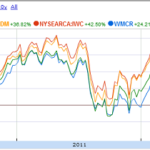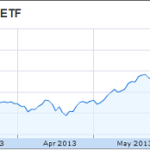Dividend stocks are hot with investors who realize that most historical stock market gains have come from dividends. The role of dividends in investment performance does not go unnoticed. Dividends also have a few other advantages for the investor:
- They serve as a guide for earnings quality. Many companies generate only accrual earnings, rarely generating cash after paying for the next batch of inventory. Dividend-paying companies can pay a dividend only in cash, an indication that their earnings are quality and consistent.
- Dividends reduce volatility. Generally speaking, a dividend can reduce volatility as a yield floor is put in place by investors on any given stock. All in, investors seem to prefer to sell zero-yielding companies before they sell the companies willing to “pay them to wait†for appreciation.
- Over the long term, companies that can consistently and reliably increase dividends paid to investors offer higher returns with less risk than companies that do not pay a dividend, or which do not consistently increase dividends paid to investors.
Selecting the right dividend fund
Several funds have sought out the highest-yielding stocks in the market. Some of these funds include the SuperDividend ETF and the Dividend Dogs funds, which select the highest yielding stocks in their respective universe.
These funds select solely on high yields, though, with no extra points given to companies that can increase their dividends year after year. Therefore, they’re most likely to hold beaten down dividend payers and high yielding REITs, neither of which necessarily present the opportunity for years upon years of dividend growth.
One of the most promising dividend growth funds is Vanguard’s Dividend Appreciation ETF (VIG). The fund uses its own unique algorithm to select quality stocks, but the first criteria is that the companies included in this $13.9 billion fund must have increased their dividend for at least 10 years in a row. The remaining criteria are kept under lock and key, but Morningstar suggests that the fund also screens for financial leverage and cash flow metrics to ensure that included companies can continue to increase their dividends year after year.
So far, the Dividend Appreciation ETF seems to be living up to its name. In the first full year of trading in 2007, the ETF returned 87.3 cents per share to investors. In 2012, it paid out $1.41. Excluding the last dividend payment – which was skewed higher by heftier dividends before rising taxes in 2013 – and including the fourth quarter 2011 dividend, the dividend per share was $1.24. Vanguard’s doing something right to find companies that have grown dividends at a compound annual rate of 7.2% per year through one of the deepest recessions in history.

For dividend growth investors who want a simple way to approach the strategy, Vanguard’s fund is a top shelf pick. Containing 154 names, it’s as diversified as any investor might need, holding a broad selection of low-volatility, high dividend growth stocks across several sectors.
Dividend Growth vs. Dividends
Investors who buy into Vanguard’s Dividend Appreciation ETF (VIG) get little more than the market is paying today. The Vanguard Dividend Appreciation ETF has a 12-month yield of 2.21% vs. 2.04% for the SPDR S&P 500 ETF (SPY).
The difference, however, is in the growth of the dividend. Whereas the Vanguard fund posted 7.2% annual dividend growth from 2007 to 2012, the broad market S&P 500 index increased its distributions by only 1.01% per year during the same period. Vanguard’s dividend growth is well in excess of the broad market despite the fact that buyers who buy today will only get a modest advantage over the market. Time pays investors plenty of favors.
The Vanguard fund trumps on total returns over the last five years, as well, returning 36.57% to investors compared to the S&P 500 return of 26.73%. Google Finance reveals Vanguard managed market beating returns with less risk, as Vanguard’s fund has a listed beta of .82, making it less volatile than the S&P 500 index.
There’s plenty of historical evidence that suggests this dividend growth fund should continue to beat and exceed the market average with less volatility. Consider making it a part of your portfolio for long-term income and capital appreciation.  Investors seeking income solely based on current yield (with some asset class diversification mixed in) could consider these myriad higher yielding ETFs herein.
Disclosure: No position in any tickers mentioned here.











{ 0 comments… add one now }